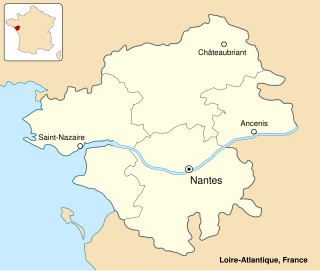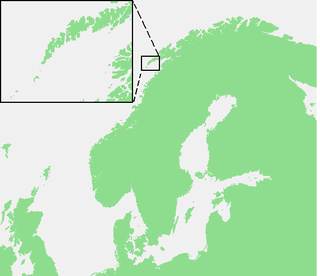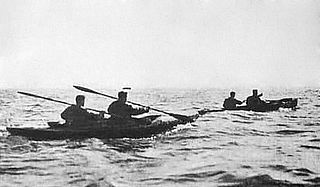Related Research Articles

A commando is a combatant, or operative of an elite light infantry or special operations force, specially trained for carrying out raids and operating in small teams behind enemy lines.

The St Nazaire Raid or Operation Chariot was a British amphibious attack on the heavily defended Normandie dry dock at St Nazaire in German-occupied France during the Second World War. The operation was undertaken by the Royal Navy (RN) and British Commandos under the auspices of Combined Operations Headquarters on 28 March 1942. St Nazaire was targeted because the loss of its dry dock would force any large German warship in need of repairs, such as Tirpitz, sister ship of Bismarck, to return to home waters by running the gauntlet of the Home Fleet of the Royal Navy and other British forces, via the English Channel or the North Sea.

The Commandos, also known as the British Commandos, were formed during the Second World War in June 1940, following a request from Winston Churchill, for special forces that could carry out raids against German-occupied Europe. Initially drawn from within the British Army from soldiers who volunteered for the Special Service Brigade, the Commandos' ranks would eventually be filled by members of all branches of the British Armed Forces and a number of foreign volunteers from German-occupied countries. By the end of the war 25,000 men had passed through the Commando course at Achnacarry. This total includes not only the British volunteers, but volunteers from Greece, France, Belgium, Netherlands, Canada, Norway and Poland. The United States Army Rangers and US Marine Corps Raiders, Portuguese Fuzileiros Portuguese Marine Corps were modelled on the Commandos.

Operation Archery, also known as the Måløy Raid, was a British Combined Operations raid during World War II against German positions on the island of Vågsøy, Norway, on 27 December 1941.

Operation Claymore was a British/Norwegian commando raid on the Lofoten Islands of northern Norway during the Second World War. The Lofoten Islands were an important centre for the production of fish oil and glycerine, used in the German war economy. The landings were carried out on 4 March 1941, by 500 men of No. 3 Commando, No. 4 Commando, and a Royal Engineers section, and 52 men from Norwegian Independent Company 1. Supported by the 6th Destroyer Flotilla and two troop transports of the Royal Navy, the force landed almost unopposed. The original plan was to avoid contact with German forces and inflict the maximum of damage to German-controlled industry. They achieved their objective of destroying fish oil factories and some 3,600 t of oil and glycerine. The force returned with some 228 German prisoners, 314 Norwegian recruits, and a number of Quisling regime collaborators.

Operation Anklet was the codename given to a British Commando raid during the Second World War. The raid on the Lofoten Islands was carried out in December 1941, by 300 men from No. 12 Commando and the Norwegian Independent Company 1. The landing party was supported by 22 ships from three navies.

The Commandos Marine, nicknamed Bérets Verts, are the special operation forces (SOF) of the French Navy, headquartered in Lorient, Brittany in western France. They operate under the Special Operations Command (COS), FORFUSCO, one of the four main forces of the French Navy or any operational command designated by the French Army staff. They specialize in offshore operations; operations from sea to land and special operations on land. One of the major characteristics of marine commando units is to be perfectly interoperable with all the resources and units of the navy.

Combined Operations Headquarters was a department of the British War Office set up during Second World War to harass the Germans on the European continent by means of raids carried out by use of combined naval and army forces.
Operation 34A was a highly classified United States program of covert actions against the Democratic Republic of Vietnam, consisting of agent team insertions, aerial reconnaissance missions and naval sabotage operations.

Shayetet 13 is a unit of the Israeli Navy and one of the primary reconnaissance units of the Israel Defense Forces. Shayetet 13 specializes in sea-to-land incursions, counter-terrorism, sabotage, maritime intelligence gathering, maritime hostage rescue, and boarding. The unit is trained for sea, air and land actions. The unit has taken part in almost all of Israel's major wars, as well as other actions.

Operation Postmaster was a British special operation conducted on the Spanish island of Fernando Po, now known as Bioko, off West Africa in the Gulf of Guinea, during the Second World War. The mission was carried out by the Small Scale Raiding Force (SSRF) and the Special Operations Executive (SOE) in January 1942. Their objective was to board the Italian and German ships in the harbour and sail them to Lagos. The SSRF under the command of Major Gus March-Phillipps left Britain in August 1941 and sailed the Brixham trawler, Maid of Honour, to the Spanish colony.
Operation Kitbag was a raid in Norway by British Commandos of No 6 Commando and No. 12 Commando in December 1941, during the Second World War.

Operation Checkmate was the codename for a raid on shipping at Haugesund, Norway in April 1943 during the Second World War by British Commandos. The raiding party consisted of seven men of No. 14 (Arctic) Commando who managed to sink one ship using limpet mines. While waiting in hiding for the transport back to the United Kingdom they were captured on 14 and 15 May 1943 and eventually taken to Sachsenhausen and Belsen concentration camps where six of them were executed, victims of the Commando Order. The seventh man died of typhus.
Operation Acid Drop was a British Commando raid during World War II. This was the first commando raid carried out by No. 5 Commando and consisted of two simultaneous operations over the night of 30/31 August 1941. Each raid consisted of one officer and 14 men, their targets were the beaches at Neufchâtel-Hardelot and Merlimont in the Pas-de-Calais, France with the aim of carrying out reconnaissance and if possible, to capture a German soldier. It was a hit and run type raid with only 30 minutes ashore but in the event neither party encountered any Germans.
Operation Crackers was a British Commando raid during the Second World War. The raid from the 23 February to the 3 March 1943 at Sognefjord in Norway, consisted of 16 men drawn from No. 10 (Inter-Allied) Commando, No. 12 Commando and No. 30 Commando. The original object of the raid was to attack an observation post and take a look at another; rough seas prevented this, so instead an observation post was manned for a week undetected, gathering information.

Operation Rumford was a British Commando raid during the Second World War. It was carried out over the night of 25/26 August 1944, by the Belgian No. 4 Troop of No. 10 (Inter-Allied) Commando who had returned to England in June and were selected to capture the French Isle of Yeu only to find during a reconnaissance that the Germans had already left.
Operation Farrier was a raid by British Commandos during the Second World War on the Yugoslavian island of Mljet.
Operation Manacle was the name given to a series of British Commando raids during the Second World War.
Operation Bristle was a British Commando raid over the night of the 3/4 June 1942 during the Second World War. The target of the raid was a German radar site, at Plage-Ste-Cecile between Boulogne and Le Touquet. The raiding force which was provided by No. 6 Commando was defeated by the strong German defences. During the return voyage at around dawn the naval force was attacked by German fighter aircraft which damaged two Motor Launches and one Motor Gun Boat, killing one Commando and two naval personnel and wounding another 19; only the arrival of Royal Air Force preventing further damage and losses.
References
- ↑ "Astrakhan | Operations & Codenames of WWII".
- ↑ "Naval codewords". Naval History. Retrieved 15 June 2010.